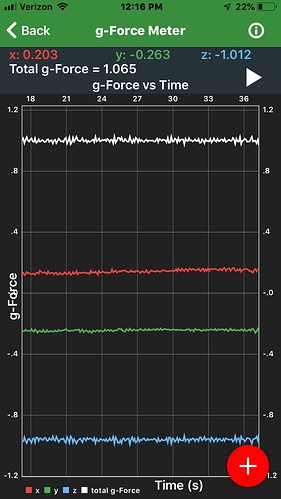I’m just back from vacation and catching up on the forum - @OP_Engr thank you for pointing me to the Physics Toolbox Sensor Suite. I think this is just what I needed. I downloaded it and tested it just now. The G-Force meter gives a very clear picture of the tremor.
My method of holding the phone is pictured below. My goal is to perform an action that is:
- Likely to induce the tremor. In this case, deliberately attempting to hold my left thumb steady always induces the tremor.
- Is easy to do the same way all the time. As this picture shows, this way of holding the phone is pretty easy and repeatable.
It took a bit of practice to figure out how to hold it, but I think I’ve got it figured out so that it will comparable from measurement to measurement.
Here is a screen capture that shows my tremor:
I just had a friend try it - she doesn’t have a tremor. She held the phone in the same way and this is the picture. Clearly different.
The app also provides a simple csv export - hooray! What I’d like to do now is convert this measurement into a score I can use for my left and right hand. I’m thinking that this score will be my dependent variable. I’m especially interested in how the tremor varies over the course of a day. I have a sense that it varies a lot, but I’m really not certain about the pattern or cause.


